Comic Strips
Comic strips are powerful conversational tools available to use in the classroom at all language levels. The strips are short conversations that don’t need sophisticated vocabulary skills to understand or talk about the content. Comic strips are an authentic resource used to motivate the reluctant student or entice the visual learner. Comics give students a glimpse into culture, trends, politics and current events in the community.
As ASL teachers, we are lucky to have a great resource with That Deaf Guy*. Matt and Kay Daigle have created wonderful comic resources to be used in your classroom. Take a look at the comic below. How could you use this in your classroom? How could students use this to communicate?
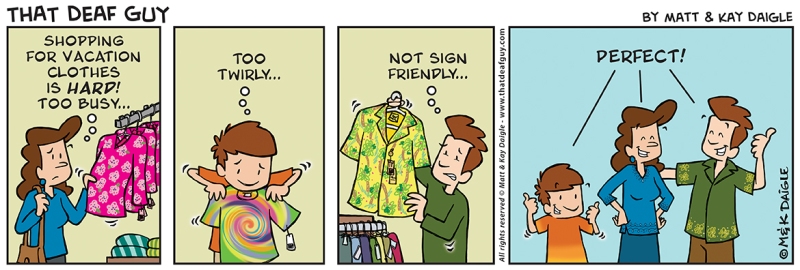
What looks like a simple cartoon strip actually has numerous possibilities for conversations. It can work as a dialogue starter with a simple question “What is happening in the picture?” Partners can discuss what they see and observe. It is a cultural conversation “Why are the shirts all solid? Why didn’t the patterned shirts work for this family?” Whiteout the conversation and have students create their own dialogue and share in class, record themselves or sign to a partner.
Comic strips can be used in a variety of ways. Here are six of my favorites:
-
Explore the theme of culture
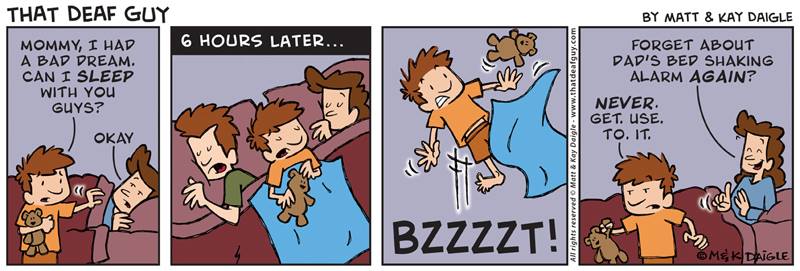
Students can have a group discussion about culture. Post conversation questions for discussion or have students create their own:
- What does it mean?
- Why is it funny?
- What aspects of culture do you observe?
- What about this situation relates to Deaf culture?
-
Analyze the humor

Every culture has its own ideas and rules of what humor is. Most of our students don’t know why certain situations would be considered humorous in the Deaf community. Use a comic strip to help students understand deaf life and experiences that may be different from their own and why they may be considered funny or not funny from one culture to the next. Incorporate them in your lectures, PowerPoints or homework assignments. Students can even create their own comic strip to depict deaf humor. There are several comic strip generators out there. Try using Make Belief Comix or Strip Generator.
-
Tell the Story

There are numerous ways to mix up storytelling with comic strips.
- Cut up pictures of the comic strip and have students put them in order and tell the story to their partner.
- Whiteout the conversation and have students create their own version of the comic strip
- Cut the last frame off the strip and have students create their own conclusion to the story
- Create their own comic strip using one of the sites listed above focusing on current vocabulary in your unit
-
Analyze characters
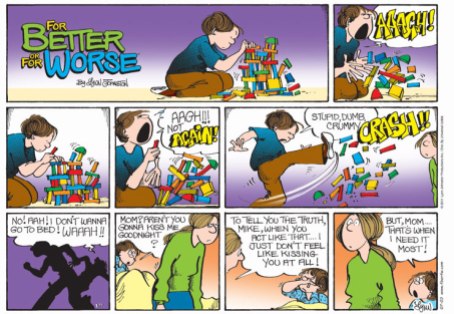
Use a series of the Deaf Guy comics or other well known comic strips so students get to know the characters. This will allow students to become familiar with the characters and be able to discuss them in more detail. That Deaf Guy has a page that describes each character’s personality and family roles. Students can check how accurate they were after the activity.
-
Roleplay

Use comic strips that show culture, vocabulary or situations you want students to be aware of. Have students recreate the strip or base a skit of their own on what they take away from the comic.
-
Make comparisons
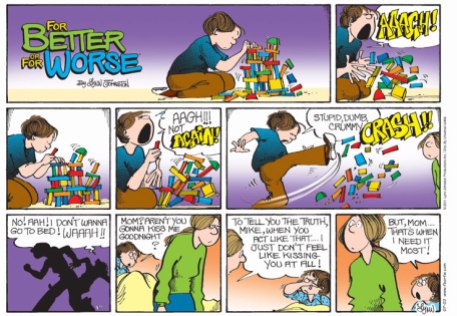
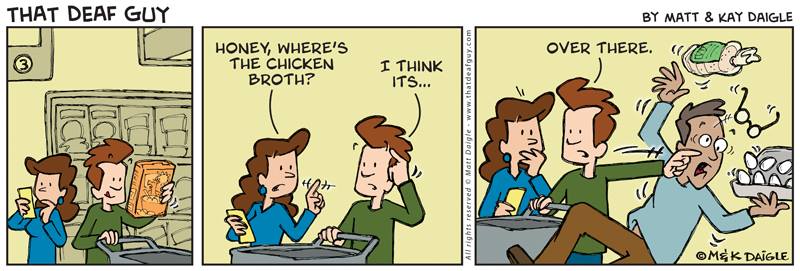
You can use two comic strips to have students make comparisons and draw conclusions. Many comic strips focus on stereotypes and you can exploit those aspects and provide students with lifelong lessons. Use comic strips to discuss clothing, politics, society, phone calls, and other real-world experiences. Compare hearing Americans to Deaf Americans. Ask students “What are the similarities? What are the differences?” Use the comics below to discuss schooling or deaf and hearing parents.


I hope you love the idea of incorporating comic strips into your lessons. I think you will find that students will enjoy them as much as you do. Don’t forget to come back and tell us how you incorporated them into your lessons.
*That Deaf Guy can be found on their website and on Facebook. I receive no compensation for promoting them but highly recommend their use as an authentic resource that provides a lot of cultural information.
Don’t forget to follow my TpT store to never miss out on a new item, sale, or a FREEBIE! And join in on the discussions happening in our Facebook group.









2 Responses
I have some of the best conversations with my 10 year old over comics. He is very visual & appeals to him on many levels. Thanks for sharing this valuable insight to take the conversations one step further.
Thanks for stopping by Heather. I am glad you found something to use in your real life. Keep communicating.
Comments are closed.